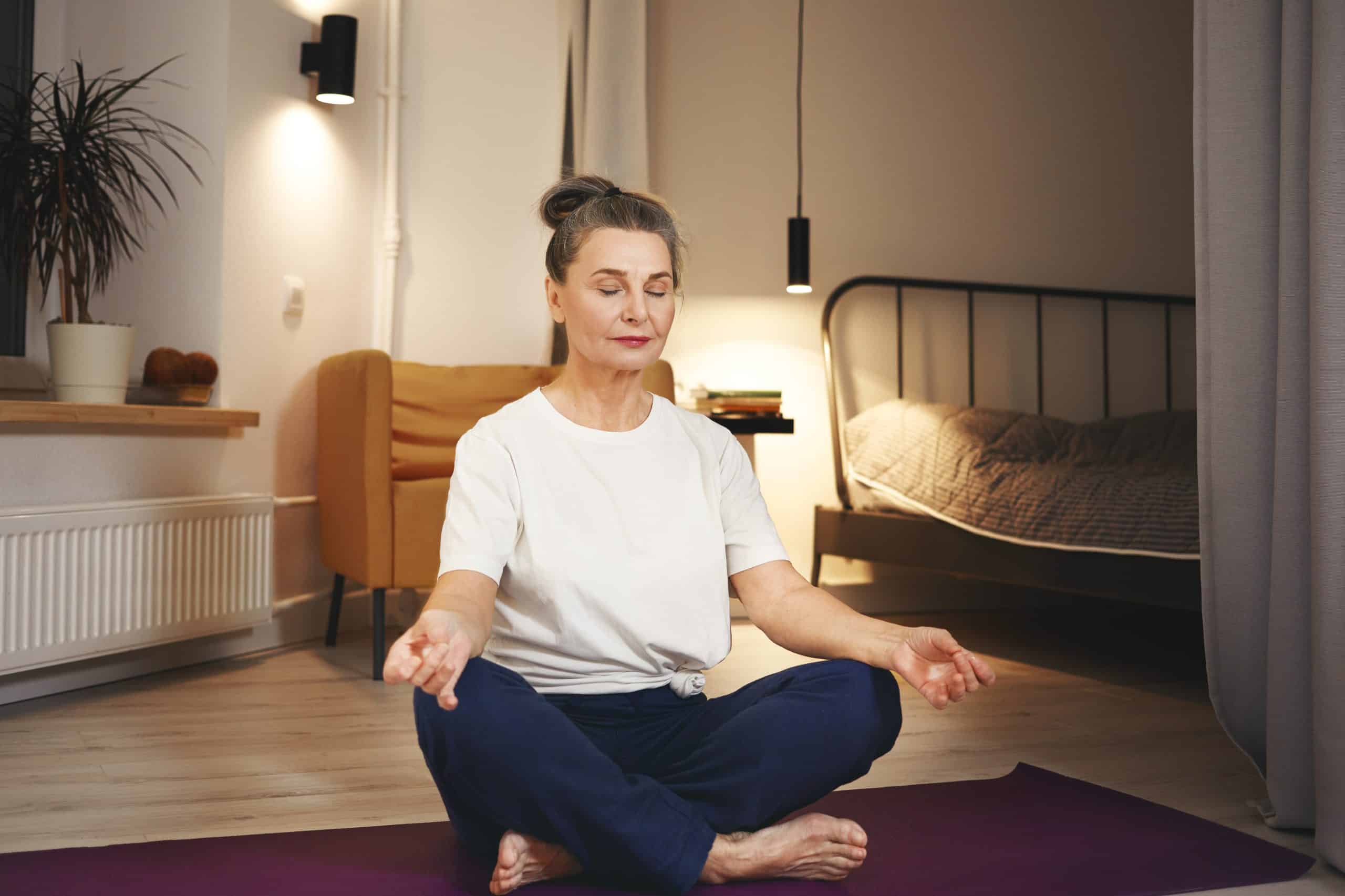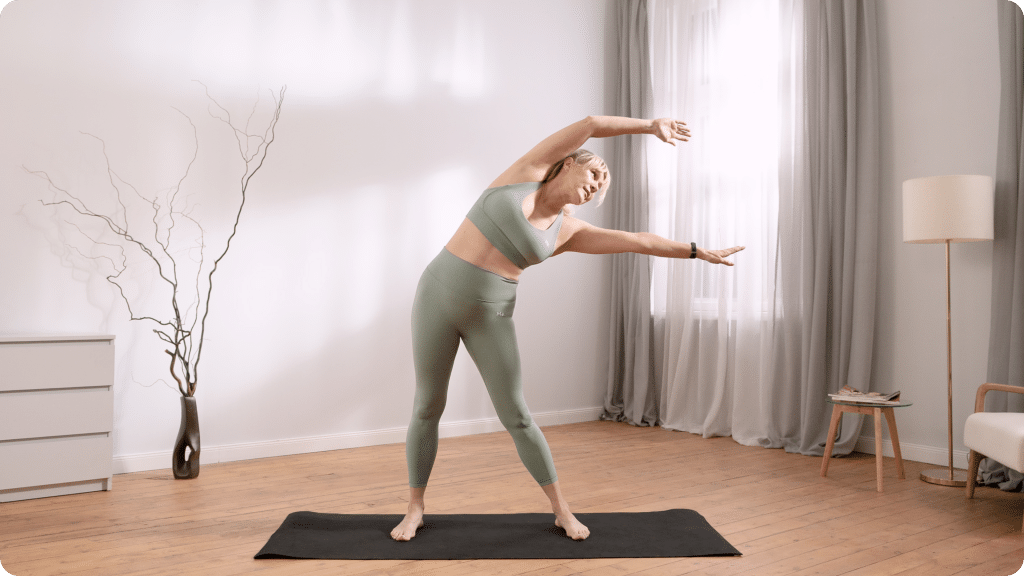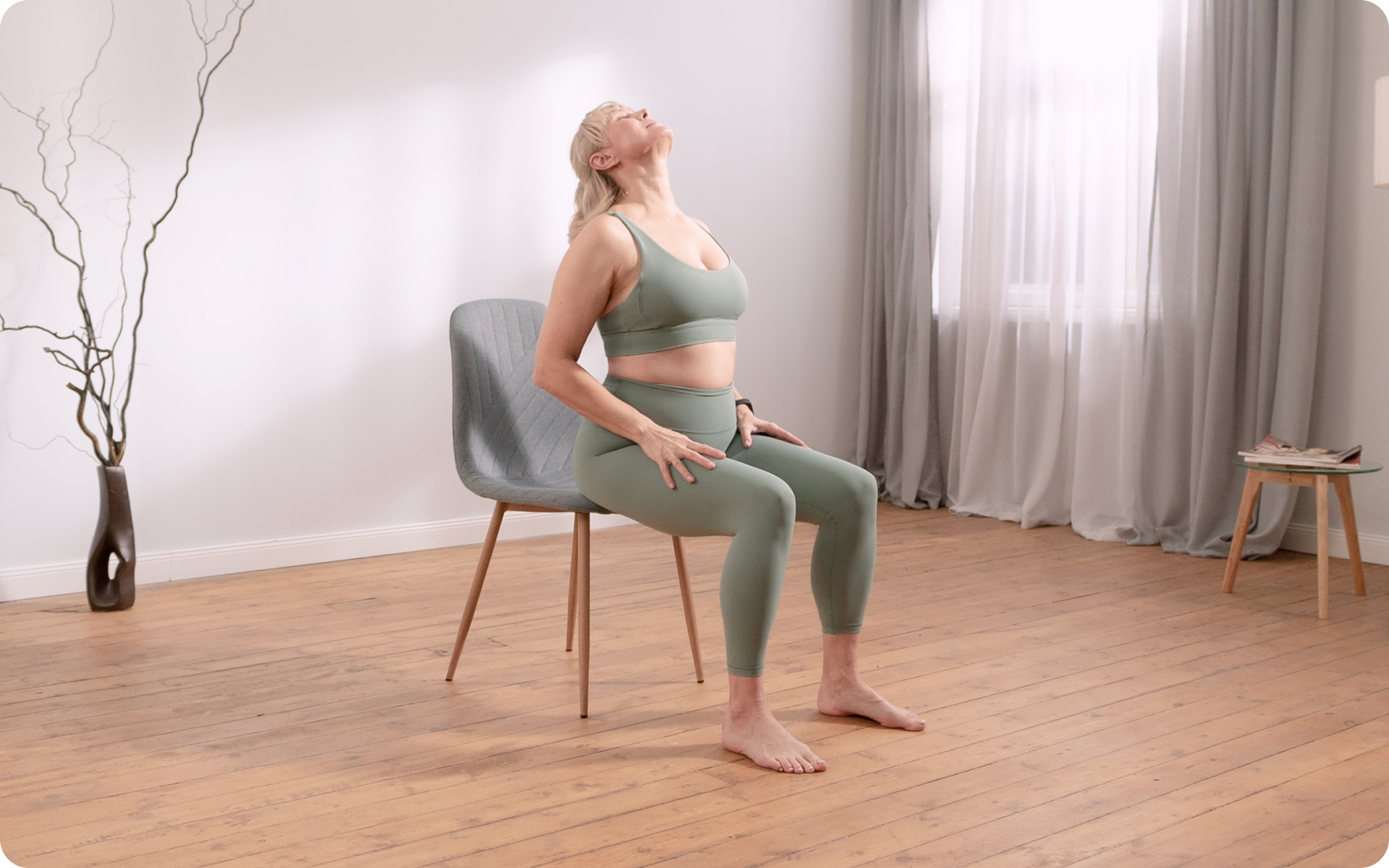Kriya yoga is “especially suited to the modern age because it does not ask anyone to believe dogmatically, but rather by practice of the proven techniques of Kriya Yoga to discover by personal realization the answer to the eternal question, ‘What is truth?’ — about oneself and God.”
These words from Paramhansa Yogananda, the father of Kriya yoga in the West, encapsulate the essence of this powerful spiritual practice (1).
He describes Kriya yoga as a practical, experiential path to understanding the ultimate truth of ourselves and our relationship with God. He compares it to a science, in which you perform experiments on yourself through meditation and breathing techniques to discover the truth for yourself. He contrasts it with other religions and spiritual practices that require blind faith, stating that Kriya yoga doesn’t ask anyone to believe blindly, but to experience and realize for oneself.
Here’s what you need to know about Kriya yoga and how you can start practicing it.
What Is Kriya Yoga?
Kriya yoga is an ancient spiritual practice that originated in India thousands of years ago. The word “kriya” means action, movement, or effort, and “yoga” means union or connection. Therefore, Kriya yoga can be translated as “the union achieved through action or effort”. It is a path to self-realization and God-realization through the use of specific techniques, mainly focused on breath control and meditation (2).
The Origins of Kriya Yoga
Kriya yoga was first taught by the great sage Babaji to his disciple Lahiri Mahasaya in the 19th century. Lahiri then passed on this knowledge to his disciple, Swami Sri Yukteswar Giri, who taught it to Paramhansa Yogananda (1). Yogananda is credited with bringing Kriya yoga to the West through his popular book Autobiography of a Yogi and his teachings (1).
Read more: Slow Flow Yoga for Beginners: A Mindful, Gentle Practice
The Philosophy of Kriya Yoga
Kriya yoga is based on the ancient Vedic teachings and draws from the principles of Raja yoga, Bhakti yoga, and Jnana yoga. Its philosophy is focused on the belief that our true nature is divine and that we can achieve union with God through self-realization (3).
The practice also emphasizes the importance of living a balanced life, incorporating both spiritual and material aspects. In the dark ages, this practice was reserved for advanced yogis and sages who relinquished worldly attachments to dedicate their lives to spiritual pursuits.
However, Yogananda believed that Kriya yoga could be beneficial for anyone in the modern world, regardless of their lifestyle or belief system.
How to Practice Kriya Yoga
The cornerstone of Kriya yoga is the practice of pranayama, or life-force control. Through specific techniques, you can calm and focus the mind, purify the body, and ultimately awaken the inner spiritual energy (known as kundalini) that leads to self-realization. The idea is to achieve inner stillness, despite the constant fluctuations of the external world.
The four main techniques of Kriya yoga are:
- Hong-Sau technique – redirecting thoughts and energy from outward distractions to attain inner peace and tranquility (4).
- Aum technique – using the power of sound vibration to awaken spiritual consciousness (5).
- Energization exercises – a series of physical, mental, and spiritual exercises that are designed to increase energy flow throughout the body (6).
- Kriya technique – a more advanced meditation practice that helps awaken kundalini energy and achieve higher states of consciousness (1).
Hong Sau Technique
Hong means “I am” and Sau means “spirit”. The Hong-Sau technique involves mentally repeating the phrase “Hong-Sau” with each inhalation and exhalation. This helps redirect the mind from external distractions and focus on your own inner spirit.
At its core, the Hong Sau technique aims to quiet the bustling chatter of the mind. It’s about redirecting thoughts from the myriad distractions of daily life to achieve a state of inner calm and clarity (4). This technique is particularly beneficial for those who are looking to problem solve, increase focus, and cultivate inner peace.
Practicing the Hong Sau technique involves a series of simple, mindful steps:
- Find Your Center: Start by sitting comfortably with your spine straight. Close your eyes and take a few deep breaths to settle in.
- Focus on the Breath: Bring your attention to your natural breathing rhythm. Don’t force it—just observe.
- Use the Mantra: As you inhale, mentally chant “Hong”, and as you exhale, chant “Sau”. These sacred syllables help anchor your mind to the breath.
- Stay Present: Whenever you notice your mind wandering, gently bring your focus back to the breath and the mantra.
- Practice Patience: Even if it feels challenging at first, maintain a gentle persistence. Over time, you’ll find it easier to maintain focus.
Aum Technique
The Aum technique is a powerful meditation practice that uses sound vibrations to awaken inner spiritual consciousness (5). Typically, the practitioner will chant the sacred syllable “Aum” (also spelled “Om”) repeatedly until it becomes a constant hum in their mind. This humming vibration helps to quiet the mind and bring about a sense of union with all creation.
It can also lead to deeper states of meditation, where you can experience the divine presence within and beyond yourself (5). Practicing the Aum technique involves deep concentration and listening:
- Prepare Your Space: Find a quiet place where you won’t be disturbed. Sit comfortably with your spine straight.
- Calm Your Mind: Start with deep breathing or practice the Hong Sau technique to achieve a state of calmness and focus.
- Listen Inwardly: Close your eyes and focus on the inner sounds. You may initially hear your heartbeat or the sound of your breath. Gradually, try to tune into the subtle sound of Aum within.
- Stay Present: Let your mind rest on this sound. If your thoughts wander, gently bring your focus back to the sound of Aum.
- Deepen the Experience: With practice, the sound of Aum will become clearer, leading to a deeper sense of peace and connection.
Energization Exercises
Developed by Paramhansa Yogananda, the energization exercises of Kriya yoga are a series of physical, mental, and spiritual exercises that help increase energy flow throughout the body (6). These exercises aim to help you gain control over your subtle energy, or prana. They teach you to consciously draw cosmic energy into the body and direct it to specific areas.
This process revitalizes the body, sharpens mental focus, and cultivates a positive mindset. These exercises are designed to prepare your body and mind for deeper meditation and spiritual growth (6).
Want to spring-clean your diet, skyrocket your self-confidence, and shatter your insecurities? Check out the BetterMe: Health Coaching app and set this plan in motion!
The full set of Energization Exercises consists of 39 individual movements. Here’s a simplified version to start with:
- Focus and Willpower: Start by using your will to tense a specific body part, directing energy there. Then relax that body part completely and feel the life force flowing within.
- Tensing and Relaxing: Gradually tense and relax from low to high tension, then back to low. This trains you to control the flow of energy.
- Double Breathing: For certain exercises, use double breathing—inhale sharply through the nose, followed by a long inhalation, then exhale through the mouth and nose in the same pattern. This helps detoxify and oxygenate the blood.
- Isolation: Focus on tensing only the specific body parts you’re working on, enhancing concentration and control.
These exercises can be completed in approximately 10-15 minutes once you’re familiar with them. They’re best practiced before meditation but can also be done at other times to recharge your energy.
Kriya Yoga Technique
The Kriya yoga technique is a more advanced meditation practice that directly works with the subtle energies of the body, aiming to awaken kundalini energy and achieve higher states of consciousness (1). It involves a specific sequence of breathwork, visualization, and mantra repetition directed at various energy centers in the body.
This technique helps purify and balance the physical, emotional, and mental bodies, clearing any blockages that may hinder spiritual growth. It also leads to intense stillness and clarity of mind (1). Kriya yoga should only be practiced under the guidance of an experienced teacher who has been authorized by an established lineage.
It isn’t recommended for beginners as it requires a certain level of physical, emotional, and mental readiness. However, for those ready to embark on this path, Kriya yoga can be a powerful tool for spiritual transformation and awakening. It’s said that the regular practice of Kriya yoga can lead to complete liberation from the cycle of birth and death.
The Benefits of Kriya Yoga
Regularly practicing Kriya yoga can unlock multiple benefits for the body and mind. These benefits aren’t instant; they unfold gradually with consistent practice. Specific research on Kriya yoga is limited, but studies on other forms of yoga and meditation have shown potential benefits (7). There are also anecdotal evidence and personal experiences that attest to the positive effects of Kriya yoga, including:
1. Inner Peace
Day-to-day life can feel relentlessly chaotic. This is particularly true in an age where capitalism and consumerism dictate your daily schedule.
The hyperconnected world we live in often leaves us feeling overwhelmed and disconnected from ourselves. Kriya yoga helps quiet the mind, dissolve stress, and cultivate inner peace amidst external chaos (8).
2. Improved Concentration
Kriya yoga teaches you to focus your attention on specific energy centers in the body while holding specific breath patterns. This intense concentration can help improve overall focus, which makes it easier to concentrate on work and other tasks (9).
3. Emotional Balance
Through breathwork, visualization, and mantra repetition, Kriya yoga helps balance emotions and create a more positive mindset. This can be particularly beneficial for those who are struggling with anxiety or depression (10).
Read more: 28-Day Chair Yoga Plan: Build A Healthy Habit With These 10 Chair Yoga Poses
4. Better Relationships with Others
As Kriya yoga helps cultivate inner peace, emotional balance, and improved concentration, it can also lead to better relationships with others. You may find yourself more patient, understanding, and compassionate toward those around you.
5. Spiritual Growth
The ultimate goal of Kriya yoga is spiritual evolution and union with the divine. Regular practice can bring about a deeper sense of connection with yourself and all creation. It can also lead to profound insights and realizations regarding the nature of existence (9).
6. Better Stress Management
Stress is linked to numerous physical and mental health issues. Poor stress management can lead to weight gain, high blood pressure, heart disease, depression, and more. Kriya yoga teaches you how to quiet the mind and release tension from the body, which makes it a powerful tool for stress management. By extension, this can also lead to improved physical and mental health (11).
Challenges and Tips for Practicing Kriya Yoga
As with any other spiritual practice, Kriya yoga comes with its own set of challenges. These can include physical discomfort, resistance from the mind, or difficulty finding a regular routine.
A common challenge for many is finding information about this ancient practice. Kriya isn’t as accessible as other forms of yoga and finding a qualified teacher can be quite challenging.
If you’re interested in exploring Kriya yoga, here are a few tips to help you get started:
- Research the practice and its lineage thoroughly before you start.
- Find an experienced and authorized teacher to guide you.
- Start with simple techniques and gradually work your way up to more advanced practices.
- Have realistic expectations and be patient with yourself; spiritual growth takes time.
- Practice regularly, even if it’s just for a few minutes each day.
- Listen to your body and mind – if something doesn’t feel right, adjust or take a break.
FAQs
What is the best way to start practicing Kriya yoga?
The best way to start practicing Kriya yoga is by enrolling in a structured course that is offered by certified organizations. These courses provide comprehensive lessons that include preliminary practices, such as the Energization Exercises, and guidance on the foundational meditation techniques. It’s important to receive proper initiation from a qualified teacher to ensure you practice the techniques correctly and safely.
Can anyone practice Kriya yoga?
Yes, anyone with sincere interest and dedication can practice Kriya yoga. It’s suitable for individuals of all ages and backgrounds. However, it requires a commitment to regular practice and an openness to spiritual growth. Beginners are encouraged to start with basic meditation practices and gradually progress to more advanced techniques as they become ready.
How does Kriya yoga differ from other forms of yoga?
Kriya yoga is distinct from other forms of yoga due to its emphasis on pranayama, or life-force control. Unlike many yoga styles that focus primarily on physical postures, Kriya yoga concentrates on the movement of energy through the spine and brain to accelerate spiritual growth. It integrates meditation, breath control, and energy awareness to harmonize the mind, body, and spirit.
What should I expect from a Kriya yoga session?
In a Kriya yoga session, you can expect a combination of preliminary exercises, focused breathing techniques, and deep meditation. The session usually starts with the Energization Exercises to prepare the body, followed by specific pranayama practices that help direct energy within. The primary goal is to achieve a state of inner stillness and heightened awareness, fostering a deeper connection with the soul.
How often should I practice Kriya yoga?
It’s recommended to practice Kriya yoga daily. Regular practice helps cultivate consistency and depth in meditation, which facilitates spiritual progress. Devotees often practice twice a day, in the morning and evening, to maintain a balanced and mindful state throughout the day.
The Bottom Line
Kriya yoga is a powerful and transformative spiritual practice that can lead you to discover the truth about yourself and your connection with God.
It doesn’t require blind faith or adherence to any specific religion and allows individuals to experience and realize their own truth through dedicated practice.
If you’re seeking a practical, experiential path to self-realization, Kriya yoga may be worth exploring.
DISCLAIMER:
This article is intended for general informational purposes only and does not serve to address individual circumstances. It is not a substitute for professional advice or help and should not be relied on for making any kind of decision-making. Any action taken as a direct or indirect result of the information in this article is entirely at your own risk and is your sole responsibility.
BetterMe, its content staff, and its medical advisors accept no responsibility for inaccuracies, errors, misstatements, inconsistencies, or omissions and specifically disclaim any liability, loss or risk, personal, professional or otherwise, which may be incurred as a consequence, directly or indirectly, of the use and/or application of any content.
You should always seek the advice of your physician or other qualified health provider with any questions you may have regarding a medical condition or your specific situation. Never disregard professional medical advice or delay seeking it because of BetterMe content. If you suspect or think you may have a medical emergency, call your doctor.
SOURCES:
- Kriya Yoga Royal Technique (2024,yssofindia.org)
- Kriya Yoga (2024,kriya.org)
- Discover the history of an ancient science perfectly suited for our contemporary world. (n,d,yogananda.org)
- Hong-Sau Meditation Phases (n,d,ananda.org)
- AUM TECHNIQUE (2015,paramhansayogananda.com)
- The Energization Exercises of Paramhansa Yogananda (2024,ananda.org)
- Exploring the therapeutic effects of yoga and its ability to increase quality of life (2011,nih.gov)
- Learn about the revolutionary positive changes that come through the practice of the techniques of Kriya Yoga (2024,yogananda.org)
- The Concept of Kriyayoga (2019,odisha.gov.in)
- Kriya Yoga in Patients with Depressive Disorders: A Pilot Study (2021,nih.gov)
- Quantitative EEG correlates of ‘Kriya yoga’ benefits for mental health among health care providers (2024,journals.lww.com)













